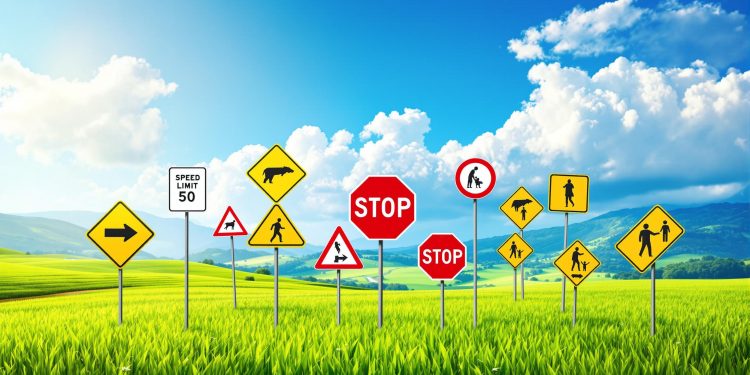Driving in Rwanda? Here’s what you need to know about road safety: Rwanda’s road signs are designed to keep traffic organized and reduce accidents. Whether you’re a local or visiting driver, understanding these signs is essential to avoid fines and ensure safety. Here’s a quick overview of the 10 most common road signs in Rwanda:
- Speed Limit Signs: Circular with red borders, speed limits vary by area (Urban: 40-50 km/h, Rural: 60-80 km/h, Highways: 80-100 km/h). Fines for speeding range from 10,000 to 50,000 RWF.
- Stop Signs: Octagonal, red background, and bold "STOP" text. Ignoring them can result in a 25,000 RWF fine.
- Yield Signs: Triangular with red borders, these require drivers to give way at roundabouts and intersections.
- Traffic Lights: Standard red, yellow, and green signals, with red-light cameras enforcing compliance.
- Pedestrian Crossings: Marked with zebra stripes; drivers must stop completely for pedestrians or face penalties.
- No Passing Zones: Circular signs with two crossed-out cars, reinforced by continuous white road lines.
- No Parking Areas: Circular red-bordered signs with a crossed-out "P", common in busy urban zones.
- Road Work Warnings: Bright orange or yellow signs indicating construction zones with reduced speed limits.
- No U-turn Zones: Circular signs with a crossed-out black arrow, often found at busy intersections.
- Emergency Vehicle Signs: Blue signs indicating priority routes for ambulances and other emergency services.
Quick Tip:
Rwanda enforces strict traffic rules with tools like speed cameras, red-light cameras, and CCTV. Violations can lead to fines, detention, or license suspension. Always follow the signs and stay informed through platforms like AutoMag.RW for updates.
Keep reading to learn more about each sign and how they contribute to safer roads in Rwanda.
Warning Road Signs in Rwanda
1. Speed Limit Signs
In Rwanda, speed limit signs are easy to recognize: they’re circular with red borders and feature black numbers on a white background [1].
Here’s a quick breakdown of the key speed limits:
| Area Type | Speed Limit |
|---|---|
| Urban Areas | 40-50 km/h |
| Rural Roads | 60-80 km/h |
| Highways | 80-100 km/h |
Penalties for exceeding these limits can range from 10,000 to 50,000 RWF, and repeated violations may even lead to imprisonment [3].
Drivers should pay close attention to speed changes, especially in the following situations:
- Moving between urban and rural areas
- Near schools or construction zones
- In areas with high pedestrian activity [1][3]
Knowing these limits is crucial as we move on to another important sign: mandatory stops.
2. Stop Signs
In Rwanda, stop signs follow international standards. They have the familiar octagonal shape, a red background, and a white border. The word "STOP" is displayed in bold white capital letters at the center, ensuring clarity for both local and international drivers [1][2].
These signs are placed at critical locations, such as high-risk intersections, unlit junctions, and blind curves [1].
When you encounter a stop sign in Rwanda, you’re required to come to a complete stop at the marked stop line or just before entering the intersection. Always check all directions for oncoming traffic before moving forward [1][2].
Failing to comply can result in a 25,000 RWF fine for a first offense [3]. Repeat violations could lead to license suspension, and causing an accident through non-compliance may result in criminal charges under Rwanda’s traffic laws.
Knowing how to handle stop signs is key to understanding the rules for yield signs, which we’ll cover in the next section.
3. Yield Signs
Yield signs are triangular with red borders and white backgrounds, signaling drivers to give way to others on the road [1]. You’ll often see them at roundabouts, merge points, and T-intersections where smaller roads meet larger ones [1][2].
Unlike stop signs, which require a complete stop, yield signs allow drivers to proceed without stopping – if the road is clear. However, drivers must always give priority to traffic that has the right-of-way [1]. When approaching a yield sign, here’s what drivers should do:
- Slow down to assess the situation.
- Check for oncoming traffic and pedestrians.
- Yield to vehicles with the right-of-way.
- Proceed only when it’s safe to do so [1].
You’ll most commonly find yield signs in these spots:
- At roundabout entrances
- Where highways merge
- At junctions where minor roads meet main roads
- At parking lot exits leading onto busy streets [1][2]
Failing to follow yield sign rules can result in fines under RNP enforcement [3]. Proper adherence to these signs plays a key role in improving road safety across Rwanda.
Next, we’ll dive into how Rwanda’s traffic light systems work and why understanding them is just as important.
4. Traffic Light Signals
Rwanda follows the familiar three-color traffic light system [1][3]. These signals are used in busy areas such as intersections, roundabouts, and complex junctions, particularly in urban hubs like Kigali, to regulate traffic flow [3][5].
Here’s what each color means and what drivers should do:
| Color | Meaning | Action Required |
|---|---|---|
| Red | Stop | Come to a complete stop |
| Yellow/Amber | Warning | Get ready to stop |
| Green | Go | Proceed if the way is clear |
To improve compliance, Rwanda has installed red-light cameras at critical intersections [3]. These cameras automatically record vehicles that run red lights, helping to enforce traffic rules.
Drivers approaching traffic lights in Rwanda should:
- Slow down when the light turns yellow and stop fully at red.
- Ensure the intersection is clear before proceeding on green.
- Be aware of red-light cameras, especially at high-risk crossings [3].
Violating these rules can result in fines, as outlined by the Rwanda National Police (RNP). The automated systems are particularly effective at reducing offenses in areas prone to accidents [6]. Paying attention to these signals is especially important near pedestrian zones, which we’ll cover next.
5. Pedestrian Crossings
Pedestrian crossings play a key role in road safety, especially after addressing traffic light compliance. In Rwanda, these crossings are marked with zebra stripes and warning signs to ensure visibility. They are particularly important in urban areas like Kigali, where pedestrians accounted for 32% of road fatalities in 2021. However, enforcement efforts have contributed to a 17% reduction in fatalities since 2016 [4].
Here’s what makes pedestrian crossings stand out:
- Zebra stripes painted on the road for clear visibility.
- Warning signs to alert drivers about pedestrian zones.
- Speed control measures implemented near crossings.
Rwanda National Police (RNP) officers closely monitor these zones during peak hours to ensure drivers follow pedestrian safety rules [3].
| Driver Responsibility | Penalty |
|---|---|
| Stop completely for pedestrians | 10,000 RWF fine |
| Reduce speed when approaching | 24-hour detention |
Drivers are required to stop at crossings, even if no pedestrians are immediately visible [1][5]. Severe violations may result in multiple penalties [4].
Understanding and respecting pedestrian crossings also helps drivers navigate other restricted zones, such as no-passing areas.
sbb-itb-7bc66b5
6. No Passing Zones
In Rwanda, no passing zones are marked with circular signs bordered in red, showing two cars crossed out[1][7]. These signs are placed in areas like sharp bends, hilltops, and spots with poor visibility – places where overtaking could lead to head-on collisions.
Road markings back up these rules. Continuous white lines on the road mean overtaking is not allowed[5]. Drivers can only pass when the line changes to a broken pattern, indicating it’s safe to do so.
"No passing zones significantly contribute to road safety in Rwanda by preventing dangerous overtaking maneuvers in areas with limited visibility or hazardous road conditions"[1][5].
Breaking this rule can result in fines up to 10,000 RWF or even 24-hour detention[4]. However, emergency vehicles with active sirens are allowed to bypass these restrictions when needed[7].
Knowing these rules not only ensures safer driving but also promotes respect for other regulated zones, like parking areas.
7. No Parking Areas
Parking restrictions play a key role in keeping urban areas organized and traffic flowing smoothly. In Rwanda, No Parking signs are easy to spot – they feature a circular red border, a blue background, and a white ‘P’ crossed out[1][5].
In cities like Kigali, these signs are placed in areas where parked cars could block traffic. Common spots include:
- Hospital entrances
- Government offices
- Bus stops
- Busy commercial zones
Some signs also include panels below them that specify time-based restrictions, so it’s worth checking those details[6].
Traffic cameras and patrols from the Rwanda National Police (RNP) keep a close eye on these zones[3].
"No Parking zones have reduced congestion by 22% in central Kigali since 2022[3]"
Quick stops of less than five minutes are allowed for dropping off or picking up passengers or goods[1][5]. However, ignoring these rules can result in fines similar to other traffic violations[4].
8. Road Work Warnings
Road work warning signs play a key role in keeping Rwanda’s growing road network safe. These signs are brightly colored in orange or yellow to grab the attention of drivers as they approach construction zones[1][3].
The Rwanda National Police (RNP) manages several common construction warning signs. For example, the "Men at Work" sign is triangular with an image of a person digging, while the "Road Work Ahead" sign is diamond-shaped and features clear text warnings[1][3].
In construction zones, drivers are required to follow temporary speed limits, which are monitored and enforced by traffic authorities[3]. These areas are marked by bright orange barriers, workers wearing high-visibility clothing, and signs indicating reduced speed limits[3].
To ensure safety in these zones, the RNP enforces strict regulations. Drivers are expected to:
- Reduce their speed
- Stay vigilant for workers
- Follow lane change instructions
- Maintain a safe distance from other vehicles
These temporary measures also help prepare drivers to comply with permanent traffic rules, such as no U-turn restrictions.
9. No U-turn Zones
Understanding temporary construction zone rules helps drivers adapt to permanent restrictions like no U-turn zones.
No U-turn zones are marked by circular signs with a red border and a crossed-out black arrow, signaling that U-turns are not allowed in certain high-risk areas[1]. These signs are typically placed in:
- Urban intersections with heavy traffic
- Locations with significant pedestrian activity
- Areas near median strips
- The start of one-way streets[1][5]
In Kigali, the capital city, these zones have played a role in smoother traffic flow and safer roads[3]. Violating no U-turn signs can result in fines up to 10,000 RWF or even a 24-hour detention[4].
When drivers encounter no U-turn signs, they need to find alternative ways to proceed, such as:
The Rwanda National Police ensures these rules are followed[3]. However, emergency vehicles with active warnings are permitted to bypass these restrictions[5].
10. Emergency Vehicle Signs
Emergency vehicle signs in Rwanda feature blue backgrounds with white symbols, such as an "H" for hospitals or ambulance icons, to indicate priority routes[1][5].
In cities like Kigali, drivers commonly encounter two types of emergency-related signs:
- Static Warning Signs: These are permanent signs that highlight emergency routes and facilities[1][5].
- Active Emergency Signals: These include blue flashing lights and sirens used by emergency vehicles to signal the need for immediate right-of-way[1][5].
The Rwanda National Police emphasizes the importance of proper driver response through public safety campaigns[3][4]. When faced with emergency vehicles using active signals, drivers are required to:
- Slow down and pull over.
- Keep intersections clear.
- Avoid blocking emergency routes.
Ignoring these protocols can lead to monetary fines[4]. Responding appropriately to emergency signs is crucial for ensuring that emergency services can operate effectively, contributing to Rwanda’s progress in road safety.
Understanding emergency signage is a key part of mastering Rwanda’s traffic rules, alongside speed limits and right-of-way practices.
Road Signs: Rwanda vs East Africa
Rwanda’s traffic system stands out in the region, showcasing some distinct characteristics compared to its East African neighbors. These differences are evident in driving rules, traffic management systems, and pedestrian safety measures.
One key distinction is Rwanda’s right-hand traffic system, unlike left-hand driving countries like Kenya and Uganda. This difference influences how road signs are placed and understood, which is especially important given Rwanda’s strict traffic rule enforcement.
Rwanda also employs more advanced traffic management systems compared to its neighbors:
- Smart Traffic Lights: These adjust their timing based on real-time traffic flow.
- Red-Light Cameras: Automated systems to enforce compliance.
- Digital Signage: Variable message signs on major highways provide real-time updates, a feature not commonly seen in nearby countries.
Pedestrian safety is another area where Rwanda excels. Zebra crossings are highly visible with bold black-and-white stripes and overhead signage[1]. Many urban areas also include pedestrian-activated signals, going beyond what is typically found in other East African countries.
| Feature | Rwanda | Other East African Countries |
|---|---|---|
| Driving Side | Right-hand | Left-hand |
| Speed Limit Signs | Circular with red border | Often rectangular (e.g., Kenya) |
| Enforcement | Cameras + police checks | Primarily manual |
Rwanda is also ahead in adopting modern signage for emerging needs:
- Signs for pollution control.
- Markers for EV charging stations, aligning with the country’s growing electric vehicle market.
- Real-time digital displays for traffic updates.
These advancements highlight Rwanda’s commitment to modernizing its traffic system while adhering to international standards[2]. Such efforts make Rwanda’s signage system not only distinct but also crucial for drivers to navigate effectively.
Conclusion
Rwanda’s road sign system plays a key role in keeping traffic organized and ensuring safety. With tools like red light cameras and a well-structured traffic management system, the country has set a high standard for road safety in the region.
AutoMag.RW is a go-to source for updates on traffic rules and safety measures. Their platform offers resources like driving guides and detailed information on regulations, helping drivers navigate Rwanda’s roads with confidence.
Understanding and following these signs is essential for safe driving. The system works best when drivers comply with the rules, aided by clear communication and consistent enforcement.
For the latest updates, check out the driving tips section on AutoMag.RW or visit the Rwanda National Police portal.
Related Blog Posts
- 5 Common Car Shipping Issues to Rwanda
- 10 Tips for Long Drives in Rwanda
- Best Websites for Buying Cars Online in Rwanda
- 5 Scenic Day Drives Near Kigali





